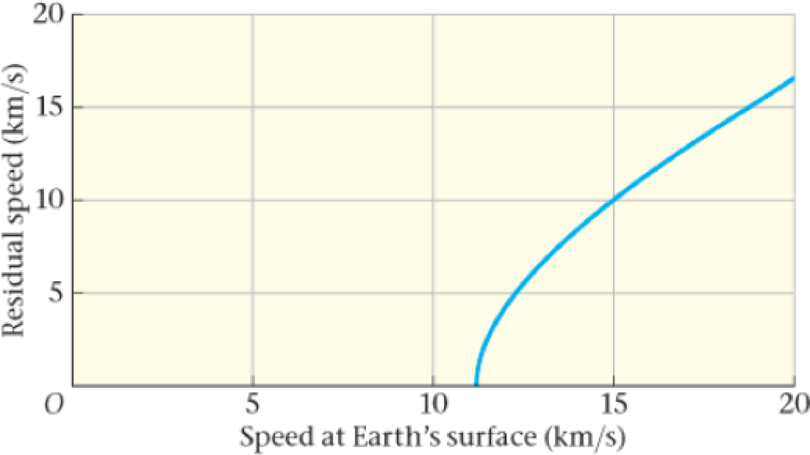
Concept explainers
If life exists elsewhere in our solar system, it may not have developed independently from life on Earth. Instead, it’s possible that microbes from Earth may have colonized other planets or moons by hitching a ride on a rock blasted from Earth’s surface by a meteor impact. If the impact gives the rock enough energy to escape into space (while at the same time not raising its temperature so high as to “cook” the microbes), the rock may eventually reach another body in the solar system. In fact, rocks from Mars are known to have reached Earth in just this way, although none are currently known to have contained microbes. Computer modeling can be used to estimate the probability that a rock ejected from the surface of the Earth with a speed greater than the escape speed will reach another planet. These computer models indicate that under the influence of gravitational fields from the other objects in the solar system, an ejected rock can take millions of years to travel from one planet to another. During this time any life “aboard” is continually exposed to the high
The accompanying plot shows the residual speed of an ejected object—that is, the speed the object would have when infinitely far from the Earth—as a function of its speed at the surface of the Earth (its original ejection speed). By simulating the motion of rocks ejected from the Earth with a variety of speeds, researchers conclude that 0.03% of the rocks ejected such that they have a residual speed of 2.5 km/s will have reached Mars 2.0 million years later. Although this doesn’t seem like a high probability, there have been so many meteor impacts over the long history of the Earth that many ejected rocks must have reached Mars—though whether they carried microbes, and if they did, whether the microbes would have survived, are open questions.

92. • What is the speed a rock needs to be given at the surface of the Earth in order for it to have a residual speed of 2.5 km/s?
- A. 8.7 km/s
- B. 10.9 km/s
- C. 11.5 km/s
- D. 13.7 km/s
Want to see the full answer?
Check out a sample textbook solution
Chapter 12 Solutions
Physics (5th Edition)
Additional Science Textbook Solutions
Introductory Chemistry (6th Edition)
College Physics: A Strategic Approach (3rd Edition)
Microbiology: An Introduction
Microbiology: An Introduction
Anatomy & Physiology (6th Edition)
Microbiology with Diseases by Body System (5th Edition)
- Two complex values are z1=8 + 8i, z2=15 + 7 i. z1∗ and z2∗ are the complex conjugate values. Any complex value can be expessed in the form of a+bi=reiθ. Find r and θ for z1z2∗. Find r and θ for z1/z2∗? Find r and θ for (z1−z2)∗/z1+z2∗. Find r and θ for (z1−z2)∗/z1z2∗ Please explain all steps, Thank youarrow_forwardAn ac series circuit consists of a voltage source of frequency 60 Hz and voltage amplitude V, a 505-Ω resistor, and a capacitor of capacitance 7.2 μF. What must be the source voltage amplitude V for the average electrical power consumed in the resistor to be 236 W? There is no inductance in the circuit.arrow_forwardAn L−R−C series circuit has R= 280 Ω . At the frequency of the source, the inductor has reactance XLL= 905 Ω and the capacitor has reactance XC= 485 Ω . The amplitude of the voltage across the inductor is 445 V . What is the amplitude of the voltage across the resistor and the capacitor? What is the voltage amplitude of the source? What is the rate at which the source is delivering electrical energy to the circuit?arrow_forward
- A 0.185 H inductor is connected in series with a 98.5 Ω resistor and an ac source. The voltage across the inductor is vL=−(12.5V)sin[(476rad/s)t]vL. Derive an expression for the voltage vR across the resistor. Express your answer in terms of the variables L, R, VL (amplitude of the voltage across the inductor), ω, and t. What is vR at 2.13 ms ? Please explain all stepsarrow_forwardA worker lifts a box under the following conditions:Horizontal distance (H): 30 cmInitial height (V): 60 cmVertical travel (D): 50 cmTorso rotation (A): 30°Frequency: 3 times/minute for 1 hourGrip: Good Question:What is the RWL for this task?What does this value mean in terms of occupational safety?arrow_forwardCan someone helparrow_forward
- Can someone help mearrow_forward3. Four identical small masses are connected in a flat perfect square. Rank the relative rotational inertias (IA, IB, IC) about the three axes of rotation shown. Axes A and B are in the plane of the square, and axis C is perpendicular to the plane, through mass m1. ΙΑ IB m2 m1 m3 Ic m4 (a) IAarrow_forwardConsider the circuit shown in the figure below. (Assume L = 5.20 m and R2 = 440 Ω.) (a) When the switch is in position a, for what value of R1 will the circuit have a time constant of 15.4 µs? (b) What is the current in the inductor at the instant the switch is thrown to position b?arrow_forwardCan someone helparrow_forwardCan someone help mearrow_forwardA particle in a box between x=0 and x=6 has the wavefunction Psi(x)=A sin(2πx). How muchenergy is required for the electron to make a transition to Psi(x)= A’ sin(7π x/3). Draw anapproximate graph for the wavefunction. Find A and A'arrow_forwardarrow_back_iosSEE MORE QUESTIONSarrow_forward_ios
 AstronomyPhysicsISBN:9781938168284Author:Andrew Fraknoi; David Morrison; Sidney C. WolffPublisher:OpenStax
AstronomyPhysicsISBN:9781938168284Author:Andrew Fraknoi; David Morrison; Sidney C. WolffPublisher:OpenStax Foundations of Astronomy (MindTap Course List)PhysicsISBN:9781337399920Author:Michael A. Seeds, Dana BackmanPublisher:Cengage Learning
Foundations of Astronomy (MindTap Course List)PhysicsISBN:9781337399920Author:Michael A. Seeds, Dana BackmanPublisher:Cengage Learning Stars and Galaxies (MindTap Course List)PhysicsISBN:9781337399944Author:Michael A. SeedsPublisher:Cengage Learning
Stars and Galaxies (MindTap Course List)PhysicsISBN:9781337399944Author:Michael A. SeedsPublisher:Cengage Learning

 Stars and GalaxiesPhysicsISBN:9781305120785Author:Michael A. Seeds, Dana BackmanPublisher:Cengage Learning
Stars and GalaxiesPhysicsISBN:9781305120785Author:Michael A. Seeds, Dana BackmanPublisher:Cengage Learning





